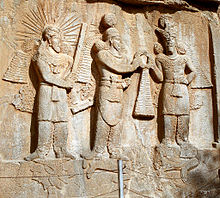Ardashir II.

Ardaschir II. († around 383) was a late antique Persian great king from the ruling house of the Sassanids . He ruled from 379 until his death in 383.
Ardashir was probably a brother of Shapur II , whom he succeeded to the throne. In some of the sources he is also referred to as the son of Schapur, but this question is still controversial in research. Apparently he became Shapur's eldest son, Shapur III. initially preferred to the line of succession; in the oriental tradition this was based on the wish of Shapur II, since his son (who was also called Shapur) was not yet old enough. Before that, Ardashir had been sub-king in the Adiabene ; in this function he was apparently prominently involved in the defensive struggle against the Roman emperor Julian (363). Julian, who died in an unclear manner during a battle, is still depicted years later on Ardaschir's investiture relief - the new king apparently claimed to have made a decisive contribution to the victory over the emperor and thus legitimized his questionable claim to the throne.
The sources say little about Ardashir's reign; Tabari's universal story is the most important source for internal relations . In religious politics, Ardashir seems to have maintained Shapur II's anti-Christian course. Armenia became a Persian protectorate again during his reign, but this did not help to resolve tensions with Rome. Temporary calm only returned when a treaty with Theodosius I , the Roman emperor in the east , was later (probably 387) . In relation to the strong nobility, Ardaschir acted powerfully, but with this he also made enemies.
On the investiture relief at Taq-e-Bostan he is shown together with Ohrmazd (or Shapur II?) And Mihr , which is unique, as there is no other known Mithra monument from Iran. The oriental sources report that the king was deposed after a few years by a meeting of nobility after he had previously acted violently against members of the aristocracy. A power struggle between Shapur III is probably behind this news . (the above mentioned son of Shapur II.) and his uncle (?) Ardaschir II., in whom both were supported by parts of the nobility and in whom Shapur was finally able to assert himself. Ardaschir does not seem to have been killed in this context.
literature
- Touraj Daryaee: Sasanian Persia. The Rise and Fall of an Empire . London 2009, p. 20.
- Karin Mosig-Walburg: Royalty and nobility in the reign of Ardashir II, Shapur III. and Truthams IV . In: Henning Börm, Josef Wiesehöfer (eds.): Commutatio et contentio. Studies in the Late Roman, Sasanian, and Early Islamic Near East . Düsseldorf 2010, pp. 133–158.
- Nikolaus Schindel: Ardashir II. In: Nikolaus Schindel (Ed.): Sylloge Nummorum Sasanidarum . Vol. 3/1 (text volume). Vienna 2004, p. 249ff.
- Theodor Nöldeke : Artaxerxes 6 . In: Paulys Realencyclopadie der classischen Antiquity Science (RE). Volume II, 1, Stuttgart 1895, column 1325.
Web links
- Ardashir II . In: Ehsan Yarshater (Ed.): Encyclopædia Iranica (English, including references)
- Reliefs in Taq-e Bostan ( Memento from February 17, 2007 in the Internet Archive )
Remarks
- ↑ Nikolaus Schindel: Ardashir II. In: Nikolaus Schindel (ed.): Sylloge Nummorum Sasanidarum . Vol. 3/1 (text volume). Vienna 2004, here p. 260f. The following presentation is largely based on the relevant articles in the Encyclopædia Iranica .
- ↑ Klaus Schippmann : Principles of the history of the Sasanid empire . Darmstadt 1990, p. 37.
| predecessor | Office | successor |
|---|---|---|
| Shapur II. |
King of the New Persian Empire 379–383 |
Shapur III. |
| personal data | |
|---|---|
| SURNAME | Ardashir II. |
| BRIEF DESCRIPTION | Persian Sassanid King |
| DATE OF BIRTH | 3rd century or 4th century |
| DATE OF DEATH | at 383 |